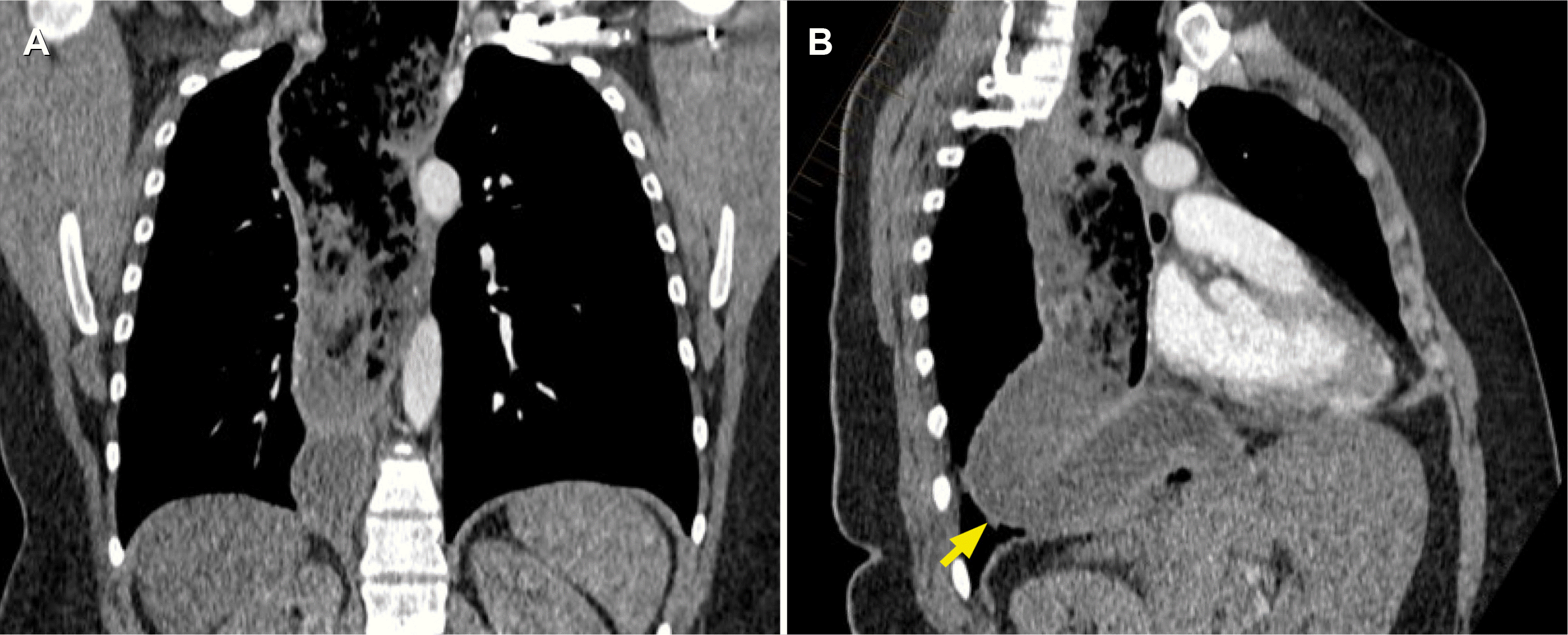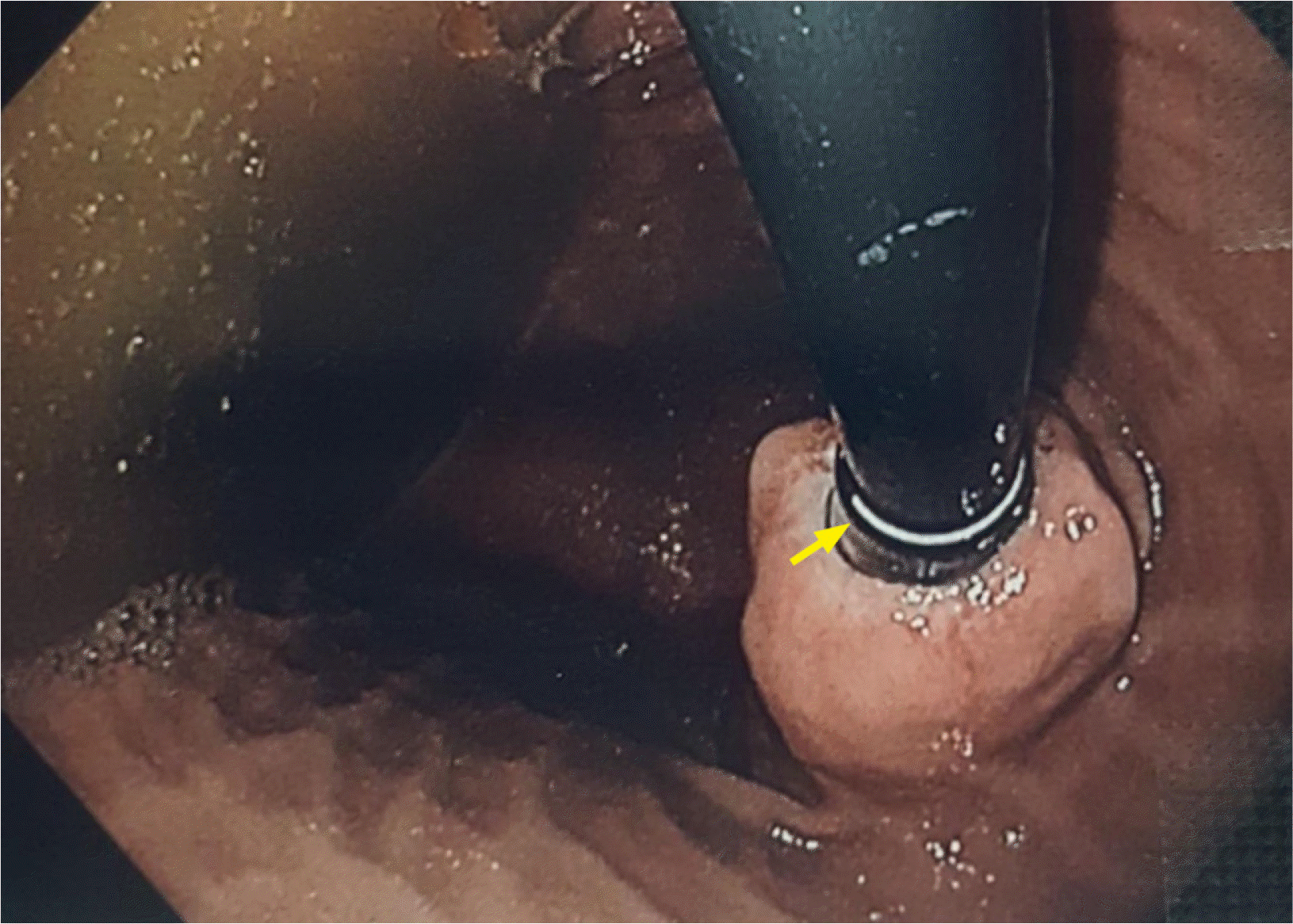This article has been
cited by other articles in ScienceCentral.
Abstract
Endoscopic retrograde cholangiopancreatography in a patient with achalasia and sigmoid esophagus poses a unique technical challenge, as one must safely guide the side viewing duodenoscope across a severely distorted distal esophagus and non-relaxing lower esophageal sphincter. In such patients, the use of an overtube is a simple solution that allows the safe passage of a duodenoscope and the removal of common bile duct stones.
Go to :

Keywords: Chlangiopancreatography, endoscopic retrograde, Esophageal achalasia
INTRODUCTION
Endoscopic retrograde cholangiopancreatography (ERCP) in patients with altered esophageal anatomy or stenosis can be challenging. Various techniques have been described for ERCP, including dilation, guidewires, and bypass with direct surgical gastric cannulation. Patients with end-stage achalasia and sigmoid esophagus are particularly challenging because the lower esophageal sphincter is unrelenting, the esophagus is severely distorted, and there is often an accumulation of large quantities of food residue. In such cases, the use of an overtube can be a straightforward solution that allows the safe passage of a duodenoscope to remove common bile duct stones.
Go to :

CASE REPORT
A 38-year-old female patient with a body mass index of 43 underwent semi-urgent laparoscopic cholecystectomy for acute cholecystitis. While bilirubin and alkaline phosphatase had been marginally elevated on admission (total bilirubin 1.58 mg/dL [normal range 0–1.23 mg/dL], conjugated bilirubin 0.58 mg/dL [normal range 0–0.53 mg/dL]; alkaline phosphatase 286 U/L [normal range 30–110 U/L]), they had rapidly normalized over a few days by the time cholecystectomy was performed. Intraoperative cholangiogram via the cystic duct showed at least one retained common bile duct stone that was impossible to retrieve. Postoperative magnetic resonance cholangiopancreatography revealed a 4 mm common bile duct stone without significant bile duct dilation. The patient had no fever, and the white blood cell count remained within normal limits. She remained clinically stable with normal vital signs and no signs of sepsis during hospitalization.
The patient required postoperative ERCP because of the retained stone; a percutaneous transhepatic approach was not feasible because of the absence of bile duct dilation. The patient had been diagnosed with achalasia in the past but had refused treatment. Over time, she developed a decompensated sigmoid esophagus with severe, chronic retention of liquid, as well as solid food residue (
Fig. 1). Contemporaneous manometry was consistent with the diagnosis, showing esophageal pressurization and a complete absence of esophageal peristalsis (while the inferior sphincter proper was difficult to assess for technical reasons). Barium esophagogram also showed a massively dilated esophagus (8.1 cm) and a bird beak appearance of the inferior esophageal sphincter.
 | Fig. 1(A) Extreme dilatation of the esophagus in a 38-year-old female patient with long-standing achalasia. (B) Acute sigmoid angulation (arrow) is observed where the redundant esophagus lies on the diaphragm. 
|
Two initial attempts at ERCP over one week were unsuccessful because of the retained foodstuffs and the extreme esophageal dilation, severe angulation in the distal esophagus, and an unrelenting lower esophageal sphincter (LES), which impeded the safe passage of the side-viewing duodenoscope into the stomach. Given the technical complexity and limited anecdotal experience of ERCP in this scenario, various alternative approaches were considered, including balloon dilation of the LES to assist in the duodenoscope passage. Furthermore, surgical intervention was considered to help guide the duodenoscope across the gastroesophageal junction using either a “rendezvous” technique or directly through a surgical gastrotomy. The solution finally adopted involved proceeding through an overtube inserted across the gastroesophageal junction using a standard gastroscope, as described by Gutierrez.
1 A third attempt at ERCP was carried out one week after several days of strict dietary restrictions, considering that the esophagus had been partially cleared of its retained contents during the first two attempts. ERCP was performed under general anesthesia and endotracheal intubation by the anesthetist. Once the stomach was intubated using a standard forward-viewing gastroscope, an overtube (Guardus
® overtube – internal diameter 16.7 mm; external diameter 19.5 mm – Steris Healthcare
®; Mentor, OH, USA) was maneuvered gently across the gastroesophageal junction using moderate pressure, without requiring prior dilation. Once in position, the overtube allowed safe passage of the duodenoscope without looping within the severely dilated esophagus (
Figs. 2,
3). Selective cannulation of the bile duct was performed using a 20 mm Dreamtome RX 45 and 0.035-inch wire (Boston Scientific, Boston, MA, USA), and a single 4 mm choledocholithiasis was extracted using the V-system 8.5 mm stone-extraction balloon. The procedure was carried out without incident (
Fig. 3). Broad-spectrum antibiotics (cefazolin and metronidazole) were administered during the entire postoperative period preceding ERCP. They were continued for 48 hours after stone extraction. The patient was discharged 48 hours after ERCP in good condition and without complications.
 | Fig. 2A non-relaxing lower esophageal sphincter “grips” an overtube (arrow) as it is being advanced into the stomach of a 38-year-old female with achalasia and sigmoid esophagus. As the semi-rigid overtube advances and straightens within the esophagus, the gastroesophageal junction can be seen invaginating into the stomach. 
|
 | Fig. 3Once in position across a non-relaxing lower esophageal sphincter, an overtube (A) allows the safe passage of a duodenoscope for an endoscopic retrograde cholangiopancreatography (B, C). A retained common bile duct stone (arrow) is then removed using a stone-extraction balloon (arrowheads outline the ends of the balloon) (D). 
|
Go to :

DISCUSSION
ERCP is the standard treatment for the removal of retained bile duct stones. On the other hand, perforation of the esophagus, which has a very high morbidity and mortality rate, is a rare but relevant complication associated with this treatment. The risk of perforation of ERCP is approximately 1%, with a mortality rate ranging from 8–23%.
2 This risk is higher in the case of conditions that distort the architecture of the esophagus, such as achalasia, stricture, and esophageal diverticula.
3 Severe end-stage achalasia with a sigmoid esophagus is a specific condition where, in addition to an unrelenting LES, the esophagus is severely distended and distorted and tends to accumulate large quantities of liquid and solid food residue, all of which may make endoscopy with a side-viewing duodenoscope particularly challenging and potentially hazardous.
Several techniques were described to address a reduced esophageal lumen and distorted esophageal anatomy when ERCP is required. One solution involves using a variety of endoscopic guides (standard guidewires, catheters, and washing pipes) positioned by standard forward-viewing endoscopy over which one can then pre-load and manoeuver the side-viewing duodenoscope across an obstruction. This technique has been used in cases of a non-relaxing upper esophageal sphincter (UES).
4-6 Another solution involves bypassing an esophageal obstruction by performing a laparoscopic gastrotomy to insert the duodenoscope directly into the stomach.
7 Percutaneous endoscopic gastrostomy is an alternative to operative gastrotomy that, once mature, can be dilated to a diameter that can accommodate the duodenoscope (approx. 12 mm).
8 Balloon dilation with or without temporary stenting of the esophageal stricture has also been described.
9
Dickey and Porter
10 were the first to describe using an overtube to allow ERCP in a patient with a neoplastic esophageal stricture requiring biliary stent placement for obstructive jaundice. The 14 mm overtube was positioned using a standard forward-viewing gastroscope, followed by inserting a duodenoscope through the overtube and successful biliary stenting.
10 There are several similar descriptions of the use of overtubes, with or without prior balloon dilation, in various obstructive esophageal disorders, including non-relaxing UES with perforated cervical (Zenker’s) diverticulum, extrinsic esophageal compression, and fibrotic stricture.
11,12 Gutierrez et al.
1 provide the only previous description of a patient with end-stage achalasia requiring ERCP, where an overtube positioned across the LES using a standard gastroscope allowed for the safe passage of a duodenoscope and emergent treatment of acute cholangitis. In the case reported by Gutierrez et al.
1, however, the patient did not have such massive dilation and angulation at the gastroesophageal junction as in the patient described here. Nevertheless, the overtube technique was adopted in the present case because it was considered the safest and most straightforward among the possible options.
ERCP in patients with end-stage achalasia and sigmoid esophagus can be particularly challenging and potentially hazardous. Positioning an overtube across the LES using standard forward-viewing endoscopy is straightforward and effective. In addition, it allows the safe passage of a side-viewing duodenoscope to perform ERCP in these patients.
Go to :







 PDF
PDF Citation
Citation Print
Print




 XML Download
XML Download